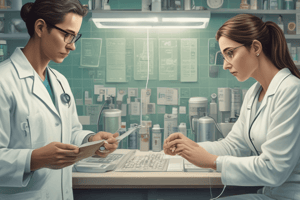Podcast
Questions and Answers
What is the primary focus of intra-test procedures?
What is the primary focus of intra-test procedures?
- Performing diagnostic tests and collecting specimens (correct)
- Preparing the client for the test
- Reporting test results to team members
- Comparing previous and current test results
What is the purpose of measuring capillary blood glucose?
What is the purpose of measuring capillary blood glucose?
- To detect ova and parasites
- To measure blood pressure
- To measure current blood glucose level (correct)
- To analyze dietary products and digestive secretions
What is an important instruction to give to a client when collecting a stool specimen?
What is an important instruction to give to a client when collecting a stool specimen?
- Void after specimen collection
- Defecate in a clean bedpan or bedside commode (correct)
- Eat a heavy meal before specimen collection
- Contaminate the specimen with urine
What is a responsibility of the nurse during intra-test procedures?
What is a responsibility of the nurse during intra-test procedures?
What is a post-test activity?
What is a post-test activity?
What is an important aspect of specimen collection?
What is an important aspect of specimen collection?
What is the purpose of a pre-test assessment?
What is the purpose of a pre-test assessment?
Why is it important to note relevant information during specimen collection?
Why is it important to note relevant information during specimen collection?
Why is it important to discard toilet tissue when collecting a stool specimen?
Why is it important to discard toilet tissue when collecting a stool specimen?
What is the purpose of collecting a 24-hour urine specimen?
What is the purpose of collecting a 24-hour urine specimen?
What is the correct procedure for collecting a clean-voided urine specimen?
What is the correct procedure for collecting a clean-voided urine specimen?
What is the purpose of a urinalysis?
What is the purpose of a urinalysis?
How long does the collection period for a 24-hour urine specimen typically last?
How long does the collection period for a 24-hour urine specimen typically last?
What is the purpose of a sputum specimen?
What is the purpose of a sputum specimen?
How long should you wait after dipping the reagent strip in urine before comparing its color with the color chart?
How long should you wait after dipping the reagent strip in urine before comparing its color with the color chart?
What should you do with the lid of the urine specimen container?
What should you do with the lid of the urine specimen container?
What is the primary focus of pre-test assessment in diagnostic testing?
What is the primary focus of pre-test assessment in diagnostic testing?
Why is it important to know if a client is pregnant during pre-test assessment?
Why is it important to know if a client is pregnant during pre-test assessment?
What type of information can be obtained from laboratory resources during pre-test assessment?
What type of information can be obtained from laboratory resources during pre-test assessment?
What is the primary purpose of obtaining a capillary blood specimen?
What is the primary purpose of obtaining a capillary blood specimen?
What is the correct procedure for collecting a urine specimen for culture and sensitivity?
What is the correct procedure for collecting a urine specimen for culture and sensitivity?
What type of specimen collection requires a concerned form?
What type of specimen collection requires a concerned form?
Why is it important to ask clients about their medication regimen during pre-test assessment?
Why is it important to ask clients about their medication regimen during pre-test assessment?
What is the primary focus of post-test care in diagnostic testing?
What is the primary focus of post-test care in diagnostic testing?
What is the primary purpose of collecting serial specimens in cytology?
What is the primary purpose of collecting serial specimens in cytology?
Why is it important to wear gloves and PPE during sputum collection?
Why is it important to wear gloves and PPE during sputum collection?
What is the purpose of offering mouth care to the client before collecting a sputum specimen?
What is the purpose of offering mouth care to the client before collecting a sputum specimen?
What is the primary responsibility of the nurse during specimen collection?
What is the primary responsibility of the nurse during specimen collection?
What is the importance of collecting specimens at the best time possible?
What is the importance of collecting specimens at the best time possible?
What should be done with the specimen container if it comes into contact with the outside?
What should be done with the specimen container if it comes into contact with the outside?
What information should be documented in the client's chart after sputum collection?
What information should be documented in the client's chart after sputum collection?
What type of specimen collection is used to diagnose tuberculosis?
What type of specimen collection is used to diagnose tuberculosis?
What is the primary purpose of a throat swab culture?
What is the primary purpose of a throat swab culture?
What is the duration required to collect a sputum specimen?
What is the duration required to collect a sputum specimen?
What is the purpose of a stool specimen and culture?
What is the purpose of a stool specimen and culture?
What is urinalysis?
What is urinalysis?
What is the primary purpose of a urine specimen and culture?
What is the primary purpose of a urine specimen and culture?
Which of the following is a common infection detected through a throat swab culture?
Which of the following is a common infection detected through a throat swab culture?
What is the primary purpose of a stool specimen and culture?
What is the primary purpose of a stool specimen and culture?
What is examined in urinalysis?
What is examined in urinalysis?
Flashcards are hidden until you start studying
Study Notes
Diagnostic Testing
- Pre-test assessment involves focusing on client preparation, assessment, and data collection to determine communication and teaching strategies.
- Assessment and data collection include biologic, psychological, sociological, cultural, and spiritual aspects.
- It's essential to know if the client is pregnant, as special precautions may be necessary or the test may need to be postponed.
- The nurse must know what equipment and supplies are needed for the specific test.
Specimen Collection and Testing
- Nurses are responsible for providing client comfort, privacy, and safety during specimen collection.
- They must explain the purpose of the test, practice aseptic technique, and follow correct procedure.
- Relevant information, such as medication that may affect results, must be noted.
- Specimens must be transported promptly and abnormal findings reported.
Stool Specimens
- The purpose of stool specimens is to determine the presence of occult blood, analyze dietary products and digestive secretion, detect ova and parasites, and detect bacteria or viruses.
- Instructions for stool collection include:
- Defecating in a clean bedpan or bedside commode
- Not contaminating the specimen with urine or menstrual discharge
- Voiding before specimen collection
- Not placing toilet tissue in the bedpan after defecation
- Sending the specimen immediately
- Collecting 2.5 cm / 1 in or 15-30 mL of stool
Urine Specimens
- Clean voided urine specimens are used for routine urinalysis and clean-catch or midstream urine specimens for urine culture.
- The first voided specimen is usually collected in the morning.
- The specimen must be free from fecal contamination.
- The container must be labeled correctly, and the lid placed lightly.
24-Hour Urine Collection
- The purpose of 24-hour urine collection is to assess the ability of the kidneys, determine disorders of glucose metabolism, and measure specific constituents such as albumin, amylase, creatinine, urobilinogen, or certain hormones.
- The collection period is 1-2 hours to 24 hours.
- The client must void and discard the initial urine, then save all urine produced during the collection period.
Urine Testing
- Urine testing includes specific gravity, pH, and the presence of glucose, ketones, protein, and occult blood.
- The principle of urine testing involves dipping the reagent strip into the urine for 2 seconds, removing excess urine, and waiting for exactly 30 seconds before comparing the color with the color chart on the test strip container.
Sputum Specimens
- The purpose of sputum specimens is to identify microorganisms and drug sensitivities.
- The specimen is collected by coughing up 4-10 mL of sputum.
- The nurse must offer mouth care to prevent contamination, wear gloves and PPE, and ensure the sputum does not contact the outside container.
Throat Culture
- A throat culture is used to check for the presence of bacteria or fungal infections in the throat.
- The sample is collected from the mucosa of the oropharynx and tonsillar region using a culture swab.
The Basic Guidelines for Specimen Collection
- Specimens must be collected at the best time possible, such as early morning sputum for AFB culture.
- Appropriate collection devices, such as sterile, leak-proof specimen containers, must be used.
- Expiration dates must be checked before inoculating the collection device.
- The test request form must be filled out fully, and the specimen labeled properly.
- There must be a suitable time between collection of the specimen and delivery to the lab.
The Role of Nurses in Specimen Collection
- Nurses are responsible for ensuring appropriate collection of samples, precise sample identification, and selecting suitable supplies for collection.
- They must also ensure timely transfer of the specimen to the lab and interact with patients during the process.
Studying That Suits You
Use AI to generate personalized quizzes and flashcards to suit your learning preferences.




